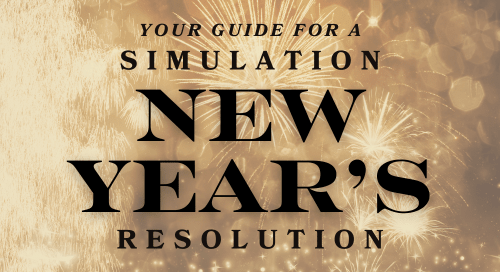
We are approaching the end of the year, and the New Year’s resolutions will be out in full force. Perhaps it’s taking up a new hobby or getting back in shape. Based on the influx of weight loss pill commercials and workout equipment fire sales which happen to occur in January every year, one can imagine what’s more popular (or profitable). What does any of this have to do with simulation? The New Year is the perfect time to see how “in shape” your simulation organization is, and start building that fitness plan.
How’s our hardware and software health?
Computational resources are everything in simulation. Whether on-premises or cloud resources, it’s a major expense and needs to match the pace at which your team is growing. If you have physical workstations, determine how old they are. Because of the expense associated with simulation machines and the pace at which hardware evolves, many simulation teams like to get 3-5 years of usage out of them. You can certainly run your machines longer than that, but you might be leaving some technical advancements on the table. Did you know some Ansys software can leverage GPU acceleration or even native GPU computing? That could be the difference your team needs to increase simulation value throughput and reduce hardware costs. Are you finding that having some extra burst capacity computing would help throughout the year? Cloud computing is like renting extra horsepower for your simulations without having to worry about maintaining the physical hardware. For some customers, this makes sense to further augment their capabilities as they encounter more time-sensitive projects or seasonal surprise projects. But it’s not just a matter of what resources you have, but how much you have.
Do you have enough hardware and software for the engineers using simulation? While it may be more cost-effective to “share” the big simulation workstation and a handful of solver licenses, you could be handicapping your team’s delivery and innovation potential. Remember, simulation engineers can multi-task extremely well. They can prepare a CAD model or mesh while another simulation is running in the background, which translates to at least one simulation solver license per engineer to truly maximize their output.
What are our technical knowledge resolutions for this year?
Maybe your team works in the HVAC industry and has mastered basic airflow CFD simulations, but can see business value for learning about particulate modeling for clean rooms. Or, perhaps you are an electronic device manufacturer that uses Ansys Mechanical for static structural simulations, but want to simulate drop testing to build a competitive advantage. Create a wish list of simulation skills your team wants to learn for this year. Set aside some time this year for each engineer to tackle learning these new skills, whether through self learning, seminars, or curated training courses. Rand Sim offers several types of enablement training ranging from 101-level introductory courses to advanced customized mentoring opportunities to help support your team’s continuing education with the Ansys toolsets.
What’s one strategic project we can work on this year?
At times, it may be hard to see the forest from the trees when caught up in the day-to-day product development activities. Simulation isn’t just about validating products for market, it’s about innovation and disruption. The question becomes, how can you spread even more of that spirit of innovation and disruption in your company? By understanding where your company is today and where it wants to go tomorrow:
-
What are my company’s strategic business goals for the next 1, 3, 5 years?
-
What industries are we strongest or weakest in?
-
What changes to our product(s) could make it a market leader?
These questions (and their answers) aren’t necessarily engineering-focused, but the “how” of the answer is. For example, if a strategic company goal is to break into the clean room filtration space, how we do that is an engineering solution. That is the intersection point between business needs, engineering excellence, and simulation. Make your company’s business goal tangible to you and your simulation team, and start crafting a roadmap to achieve it.
How can we showcase simulation to our organization?
Simulation is the cutting edge of engineering, and it’s an exciting field to be a part of. Share that passion, enthusiasm, and innovation with your peers! You may not think that a simulation for a minor design revision brought much business value, or shaving off a few pennies on a part cost matters. The truth is, it does matter and has tremendous business value. You are steering the development of your company’s product by the simulations you conduct. That’s a powerful statement. Spend some time this year finding ways to share your simulation team’s success stories with the rest of the organization. Whether it’s an email to your engineering director, or a quarterly executive presentation showcasing how simulation impacted the business, simulation advocacy starts with you. Wishing you all a Wonderful Holiday Season!
About the Author
Follow on Linkedin More Content by Krystian Link















